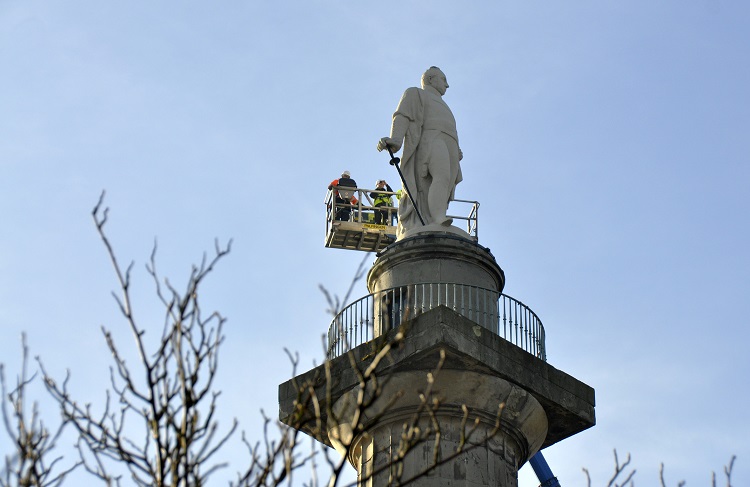Lord Hill’s statue set for repair work – as funding is sought for a replacement

Stonemasons inspect Lord Hill’s statue and The Column in February 2019
The statue of Lord Hill on top of The Column in Shrewsbury is set to undergo repair works next month (July 2019). The work – which is subject to approval from Historic England – follows an inspection carried out in February this year after several small pieces of stone were found on the ground. It’s thought they had fallen from the statue following high winds and freezing temperatures.
It’s estimated that it will take two to three days to carry out the repairs, using a truck-mounted 50-metre-high mobile platform. The work will cost approximately £10,000.
Meanwhile, Shropshire Council – supported by the Friends of Lord Hill’s Column – is seeking to secure an estimated £500,000 needed to replace the statue of Lord Hill with an exact replica made from its original material, Coade stone.

Lord Hill’s Column in the snow
The Column and Lord Hill – did you know?
Completed in June 1816 The Column was erected in honour of the Right Honourable Rowland Lord Hill, Baron of Almarez in Spain, and of Hawkstone and Hardwick Grange, Shropshire; Commander-in-Chief of the British Army; a General in the Army; Governor of Plymouth, and Colonel of the Horse Guards Blue.
Born at Prees Hall, near Hawkstone in April 1772, Lord Hill fought alongside the Duke of Wellington at the Battle of Waterloo. The Column was erected to recognise his valour in this and other campaigns. He died at Hardwicke Grange near Shrewsbury in December 1842 and was buried in the churchyard at Hadnall.
The proposal to erect a monument in his honour was first made in the Shrewsbury Chronicle in December 1813, while he was fighting heroically in the Pyrenees. The decision to build a column followed swiftly and the money was raised by the people of Shropshire through 1814.
The column was designed by 22-year old Edward Haycock using stone from the nearby quarries at Grinshill, with revisions, to the base only, by Thomas Harrison of Chester. The statute was made of Coade artificial stone, and was made by Mrs Coade’s firm in Lambeth.
The first stone was laid on December 27 1814 by the Salopian Lodge of Free Masons assisted by deputies from adjoining lodges, on the festival of St. John the Evangelist. The last stone was laid on 18 June 1816 the anniversary of the battle of Waterloo. The total expense was 5,972 pounds, 13 shillings and 2 pence.
The Column is 133 feet high (40.5 metres) and is the highest free-standing Greek Doric column in England. Its diameter is two feet wider than Nelson’s Column and, not including the pedestal, it is 13 feet higher.
The statue in particular has had a number of significant repairs and the council, along with the Friends of Lord Hill Column, are now seeking support to replace it.
As owners of the Grade II* listed Lord Hill statue and The Column, Shropshire Council has a responsibility for maintaining the structure.
The Friends of Lord Hill’s Column
The Friends of Lord Hill’s Column was formed in September 2013 and now has over 2500 Life Members. This has been achieved mainly through opening the Column on specified days so that members of the public may climb the 172 stairs to the top. This costs £5 (young people of school age and students in further education climb free) and confers automatic life membership of the Friends who can climb the column free of charge thereafter.
For more information go to www.friendsoflordhillscolumn.co.uk

